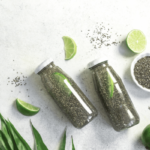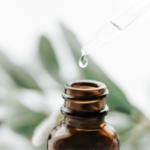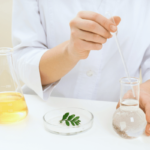active subtances
Chlorella pyrenoidosa is an extraordinary natural source of vitamins.
Vitamin A in the form of (Beta-carotene): 180mg
This powerful antioxidant agent works in particular in synergy with vitamin E and C, also contained in Chlorella. Epidemiological studies have shown that those who consume a lot of beta-carotene are less likely to develop lung, stomach or prostate cancer.
Vitamin B1 (thyamine) – B2 (riboflavin) – B3 (niacin) – B6 and Vitamin B12
Highly sought after by vegetarians, because it is often lacking in their diet, vitamin B12 plays a direct role in energy, appetite and intestinal flora.
Vitamin C – Vitamin E – Vitamin H (biotin)
Biotin acts against joint rigidity
Vitamin M (folic acid)
Chlorella pyrenoidosa contains almost twice as much as beef liver generally considered the largest source. This vitamin is usually recommended for pregnant women.
Chlorella pyrenoidosa contains 60 to 65% vegetable proteins. Which gives it the status of the richest plant nutrient in protein. A real record among plants!
For comparison, products known for their high protein content, such as soy or veal, only reach 35 and 32% respectively (13% for eggs and 3% for milk).
As it is a eukaryote, we also observe the presence of nucleic acids and amino acids. In this composition, 3% is plant RNA (ribonucleic acid) and 3% is plant DNA (deocyribonucleic acid).
In addition, the bioavailability rate of chlorella pyrenoidosa proteins is also very high, since they are absorbed at 80%, making it the food that provides the most protein to humans. For comparison, beef and poultry are only 65% digested.
Finally, chlorella pyrenoidosa contains all the amino acids in a balanced proportion: 18 AA (essential amino acids).
The C.G.F. (or chlorella pyrenoidosa growth factor) is a chlorella extract obtained by boiling the plant.
Composed of amino acids, peptides, proteins, vitamins, nucleotides, natural sugars and nucleic acids, it represents approximately 5% of the content of the algae.
The C.G.F. has a favorable effect on the whole body: it acts directly on tissue cells, as it accelerates their growth and regeneration by stimulating the functions of DNA and RNA in the production of proteins, enzymes and energy.
The C.G.F. stimulates the cells responsible for the immune response, which protect the body against infections and the appearance of cancer cells
Chlorella pyrenoidosa contains almost 3% chlorophyll, an unrivaled record among plants.
Thanks to this high chlorophyll content, the production of oxygen and the absorption of carbon dioxide, induced by photosynthesis, are ten times higher than in other plants.
Chlorophyll plays a vital role in the proper functioning of our body. Scientific studies confirm that it is nature’s most powerful cleaning agent.
Chlorophyll acts preventively. Its intake into the intestine produces an environment unfavorable to the growth of unwanted bacteria; it does not destroy them but prevents them from growing.
Chlorophyll reduces bad breath. Which explains why there are a lot of candies and chewing gum with chlorophyll.
Chlorophyll contributes to the control of calcium in the blood, facilitates the digestion of heavy proteins, increases the absorption of iron, cleans and produces blood, is effective against diseases such as anemia, arteriosclerosis, hypertension and many other conditions.
Chlorophyll provides a favorable environment for tissue reconstruction and is used successfully for the treatment of bleeding and gum infections, burns and inflammation of the skin, particularly during radiation treatments for certain cancers.
Chlorella pyrenoidosa is the plant richest in nucleic acids capable of being easily broken down and assimilated. It provides all the cells of the body with all the essential amino acids, allowing us to rebuild our genetic heritage, thus prolonging the proper functioning of our cells, and therefore that of our organs.
The RNA and DNA of chlorella pyrenoidosa are made up of very short chains of amino acids. The body requires little energy to break them down; this is an important gain and one of the reasons that promote well-being.
RNA is recognized as an anti-aging agent.
The following minerals and trace elements are also found in Chorella pyrenoidosa: calcium, potassium, phosphorus, iron, zinc, manganese, copper, chromium, selenium, sodium (little), etc.
On the other hand, being a freshwater algae, it does not contain iodine.
Chlorellin, a natural antibiotic, is also found in Chorella pyrenoidosa.
It targets any bacteria harmful to the body; it promotes and protects the growth of good bacteria in the intestinal flora. It strengthens the immune system.
Sporopollenin protects chlorella pyrenoidosa from drying out.
Thanks to the polymers of its cell membrane, including sporopollenin, chlorella pyrenoidosalises harmful substances in an irreversible manner, allowing them to be evacuated through the stools. This concerns not only metals but also pesticides, insecticides and other toxic substances.









